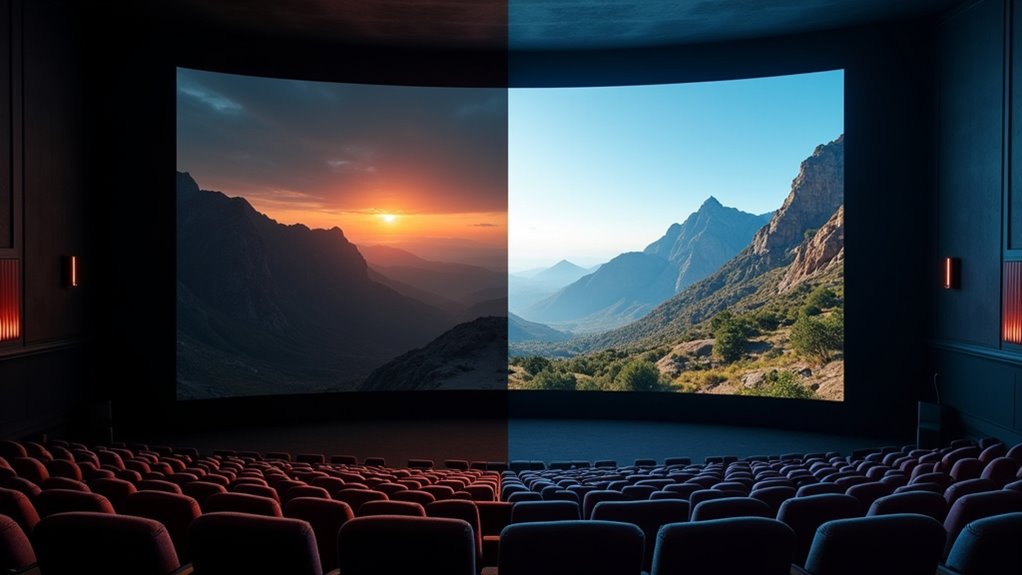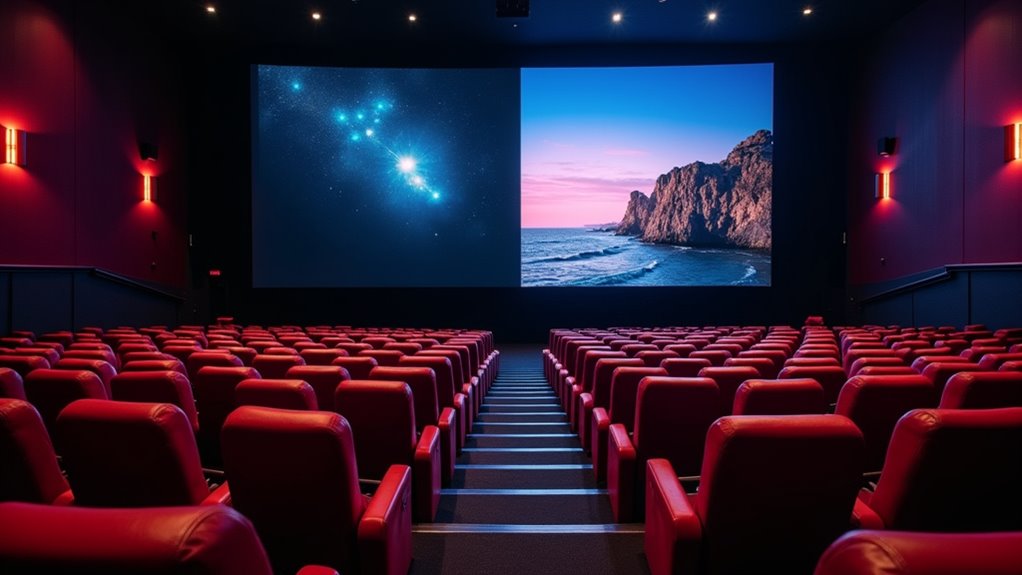While both formats offer stunning cinematic experiences, the choice between Dolby Cinema and IMAX depends on personal preferences and priorities. IMAX delivers massive curved screens with specialized aspect ratios and powerful audio, perfect for blockbusters and action films. Dolby Cinema counters with superior HDR technology, precision sound through Dolby Atmos, and luxurious reclining seats, though at a premium price point. The true battle between these titans reveals itself in the technical details and viewing experience.
The Battle of Visual Technologies: Screen Size, Resolution, and HDR

The age-old cinema rivalry between Dolby Cinema and IMAX represents a clash of visual philosophies, where each format approaches the theatrical experience through distinctly different technological lenses.
IMAX dominates with its floor-to-ceiling curved screens that engulf viewers’ peripheral vision, while Dolby Cinema compensates with precision-engineered flat screens that maximize visual clarity. IMAX’s specialized aspect ratio formats allow filmmakers to capture and display more vertical imagery than standard theaters. The theater’s dual laser projectors deliver exceptional brightness and color accuracy across the massive display surface.
While IMAX embraces immersion through massive curved displays, Dolby Cinema achieves its magic through flat screens optimized for crystal-clear picture quality.
In the resolution arena, both formats flex their technological muscles through dual laser projection systems, though they prioritize different aspects.
IMAX pushes boundaries with its massive 4K displays in laser-equipped venues, creating an encompassing viewing experience that literally towers over audiences.
Meanwhile, Dolby Cinema’s trump card lies in its standardized implementation of Dolby Vision HDR technology, delivering unparalleled color accuracy and contrast levels that make every frame pop with stunning realism.
The result is a fascinating duel where IMAX’s “bigger is better” mantra squares off against Dolby’s “pixel-perfect” precision.
Sound Systems That Transform Movies Into Experiences
Both Dolby Cinema and IMAX have revolutionized theatrical sound design through distinctly different approaches to audio immersion, transforming conventional movie screenings into multisensory experiences that rival theme park attractions.
Dolby Atmos employs up to 128 discrete audio tracks and 118 dynamic objects, allowing sound designers to place specific audio elements anywhere in the theater’s three-dimensional space, from rainfall overhead to footsteps creeping behind viewers. With its 215 powered speakers, the system delivers one of the most sophisticated audio experiences available in cinema today.
IMAX takes a more bombastic approach, utilizing custom-designed speaker systems that blanket the theater in a 360-degree soundscape, perfectly complementing their massive screens with audio that packs a punch.
While Dolby prioritizes precision and spatial accuracy with individually powered speakers that can be calibrated to specific theater geometries, IMAX focuses on raw power and impact. Since its first installation in 2012 at El Capitan Theatre in Los Angeles, Dolby Atmos has expanded to over 7,800 cinema screens worldwide.
The result is two distinct audio philosophies: Dolby’s surgical precision versus IMAX’s thunderous presence, each offering moviegoers a unique way to experience cinematic sound.
Making the Choice: Comparing Comfort, Availability, and Value

When choosing between premium cinema formats, moviegoers must weigh multiple factors that extend far beyond screen size and sound quality. The decision often boils down to practical considerations like seat comfort, theater availability, and ticket prices.
Dolby Cinema’s luxurious reclining seats offer an intimate, premium experience, though their limited locations in major urban centers can make access challenging for some viewers. With only 197 cinema screens worldwide, finding a Dolby Cinema can require significant travel for many potential patrons. The theater’s Dolby Vision HDR technology ensures viewers experience the deepest blacks and most vibrant colors possible. IMAX, with its widespread presence and stadium-style seating, provides a more accessible option that emphasizes the communal viewing experience.
Value assessment becomes highly personal, with Dolby Cinema commanding slightly higher ticket prices for its premium amenities, while IMAX delivers a more cost-effective option for experiencing cinematic grandeur.
The choice ultimately depends on individual priorities – whether one values the cozy comfort of Dolby’s adjustable seats or prefers IMAX’s proven track record with action-packed blockbusters. Film genre can also influence the decision, as certain movies are specifically crafted to showcase each format’s unique strengths.
Frequently Asked Questions
Can I Bring My Own 3D Glasses to IMAX or Dolby Cinema?
Bringing personal 3D glasses to IMAX theaters isn’t recommended due to specialized polarization technology that requires venue-specific eyewear.
While some RealD 3D glasses might work in standard theaters, IMAX’s dual projection system demands their proprietary glasses for optimal viewing.
As for Dolby Cinema, they primarily focus on 2D projection, making 3D glasses unnecessary except for special screenings that provide specific glasses.
How Long Before Showtime Should I Arrive at Premium Format Screenings?
For premium format screenings, arriving 30-45 minutes before showtime is recommended, especially for highly anticipated releases or opening nights.
This buffer allows time for parking, collecting pre-ordered concessions, and securing optimal seating positions.
During peak times like weekends or holidays, adding an extra 15 minutes provides cushion for unexpected crowds, traffic delays, or special pre-show content unique to premium formats.
Do IMAX and Dolby Cinema Offer Special Accommodations for Hearing-Impaired Viewers?
Both formats offer some accessibility features for hearing-impaired viewers, though accommodations vary by location.
IMAX theaters typically provide assistive listening devices but often lack comprehensive caption options, particularly for their specialized documentary content.
Dolby Cinema leverages its advanced Atmos sound system alongside standard accessibility tools like closed captioning devices, though availability should be confirmed with specific theaters before attending.
Are Premium Format Tickets Refundable if Technical Issues Occur?
While premium format tickets generally follow standard theater refund policies, technical issues often warrant special consideration.
Most major chains, including Cinemark, will provide full refunds or replacement tickets when significant technical problems occur during premium screenings.
However, specific policies vary by theater, and getting a refund may require speaking with management rather than relying on automated systems or standard refund windows.
Which Rows Provide the Optimal Viewing Experience in IMAX Versus Dolby Cinema?
For IMAX theaters, the sweet spot lies about two-thirds back from the screen, typically rows G-K, allowing viewers to take in the massive screen without neck strain.
Dolby Cinema offers more flexibility, with optimal viewing from rows D-H in the center section, though the advanced Atmos sound system and HDR visuals make most seats viable options, especially the recliners in the middle section.
